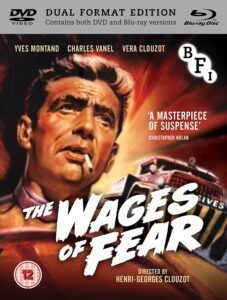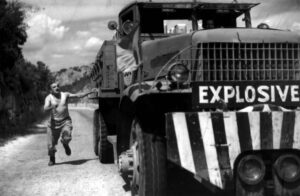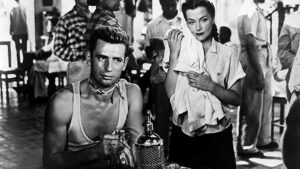“The Wages of Fear” – Clouzot’s Black Thriller

Title: “The Wages of Fear”
Release Date: 1953
Director: Henri-Georges Clouzot
Cast: Yves Montand, Charles Vanel, Folco Lulli, Peter van Eyck, Antonio Centa, Véra Clouzot
“The Wages of Fear” by Henri Georges-Clouzot from 1953 is a superbly realized thriller that combines gripping action with the pessimism of Albert Camus’ existential philosophy. The story of four daredevils deciding to risk their lives to get the coveted money does not allow the viewer to miss even a minute of the account of the transport of deadly nitroglycerin. So we accompany the heroes on the mountain road, expecting the worst at every turn. At the end, however, the awaited reward does not await, because at the heart of the story is the archetype of Sisyphus, whose boulder always rolls down the moment before reaching its goal.
“The Wages of Fear” – a story about people in a border situation
“The Wages of Fear” is the first film in the oeuvre of Henri Georges-Clouzot, which won great international acclaim. The picture is set in Venezuela in the 1950s, where lost Europeans end up for various reasons (political or conflicts with the law). The stagnation, unemployment and poverty prevailing in the provincial town deprive them of a sense of dignity and meaning in life. So when the opportunity to earn money that can completely change the fate of the emigrants arises, the men, disregarding the price they will have to pay, throw themselves at the chance. And it is the eponymous price of fear: for the Americans are offering $2,000 for drivers who decide to transport in trucks nitroglycerin to be used to control a fire in the oil fields.
The mountainous route is full of dangers, and four daredevils are finally qualified for the task: two Frenchmen – Jo (Charles Vanel) and Marlo (Yves Montand), German Bimba (Peter van Eyck) and Italian Luigi (Folco Lulli). The drivers travel in pairs in two trucks. Along the way they encounter numerous obstacles: uneven ground, a decrepit bridge over a precipice and huge boulders. In the process, they pass a test of courage and solidarity, which, paradoxically, only the cynical experienced gangster Jo fails. Unfortunately, the car with Bimba and Luigi for unknown reasons suddenly explodes, and Jo, while tearing through the spilled oil, is seriously injured in the leg. The rapidly progressing infection causes the death of a man, so only Marlo reaches his destination. The rich and happy hero, returning to the town, gets intoxicated by reckless driving and falls into an abyss. At the same moment his beloved Linda (played by the director’s wife Vera Clouzot), who is waiting for him, suddenly loses consciousness during a joyful dance.

Clouzot – a master of cinematic tension and parabola
The movie “The Wages of Fear” is structurally divided into two parts. The first – decidedly less successful – depicts the bleak existence of European emigrants in South America. The second, on the other hand, centers around a dangerous expedition with nitroglycerin. It must be said that Clouzot here gives a real display of the art of building cinematic tension. From the moment the trucks hit the road, almost every second of the screening is laden with authentic emotion. The suggestive performance of the great actors makes us almost feel their accelerated pulse and rub the sweat from our foreheads along with the characters. In constructing the drama of “The Price of Fear” a very important role is played by editing and sound, which emphasize the horror of the situation.
Nevertheless, Clouzot’s movie is not only an exemplary thriller, but also a philosophical parabola. The story told on screen is firmly rooted in French existentialism, which triumphed in the 1950s. There is a pronounced fatalism, making a positive ending impossible despite the efforts of the characters. Evil fate proves stronger than any action taken. At first it seems that Marlo is close to outsmarting destiny – for he is favored by proverbial luck. In his pocket he has an anointedly stored Paris metro ticket – his private talisman, and in the town a beautiful girl is waiting for him. The hero manages to overcome the paralyzing fear and victoriously pass the test of solidarity with his colleagues. Ultimately, however, like the mythical Sisyphus just before the finale, he fails.
“The Wages of Fear” – the story of the conscious Sisyphus
“The Wages of Fear” like existential philosophy, explicitly draws on the myth of the Corinthian king – a hero condemned to the pointless effort of rolling a large boulder uphill, which rolls downhill just before the very top. Camus and Jean-Paul Sartre believed that it is this archetypal story that best describes the human condition, but equipped Sisyphus with full awareness of imminent defeat. Therefore, the heroism of this character lies in the fact that despite the knowledge of the sad end, the hero undertakes the assigned task. The same is true in “The Wages of Fear” – the emigrants, although they have little hope of winning, decide to undertake a dangerous journey. Interestingly, however, it paradoxically gives them more than material gains.

On the road, they regain a sense of dignity that they lost while living for years on the edge of poverty and begging. They have a renewed sense of purpose and motivation, take on an important task anew, and overcome more obstacles by their own efforts. At the same time, this is a true test of humanity, in which Jo is the weakest. Cunning and fond of humiliating others, the gangster brandishing a gun turns out to be a scared coward. In a difficult moment, he leaves his companion and tries to save himself by running away. Clouzot thus shows human behavior in a borderline situation, when it is most difficult to remain true to declared values. “The Wages of Fear”, although undoubtedly a fatalistic film, is a confession of faith in the heroism of human existence, the meaning of which, according to existential thought, lies in making an effort to live despite everything.
Literature:
Literatura:
„Kino klasyczne”, pod red. T. Lubelskiego, I. Sowińskiej i R. Syski, Kraków 2012.
A.Garbicz, J. Klinowski, “Kino, wehikuł magiczny. Podróż druga 1950 – 1959”, Kraków 1987.

